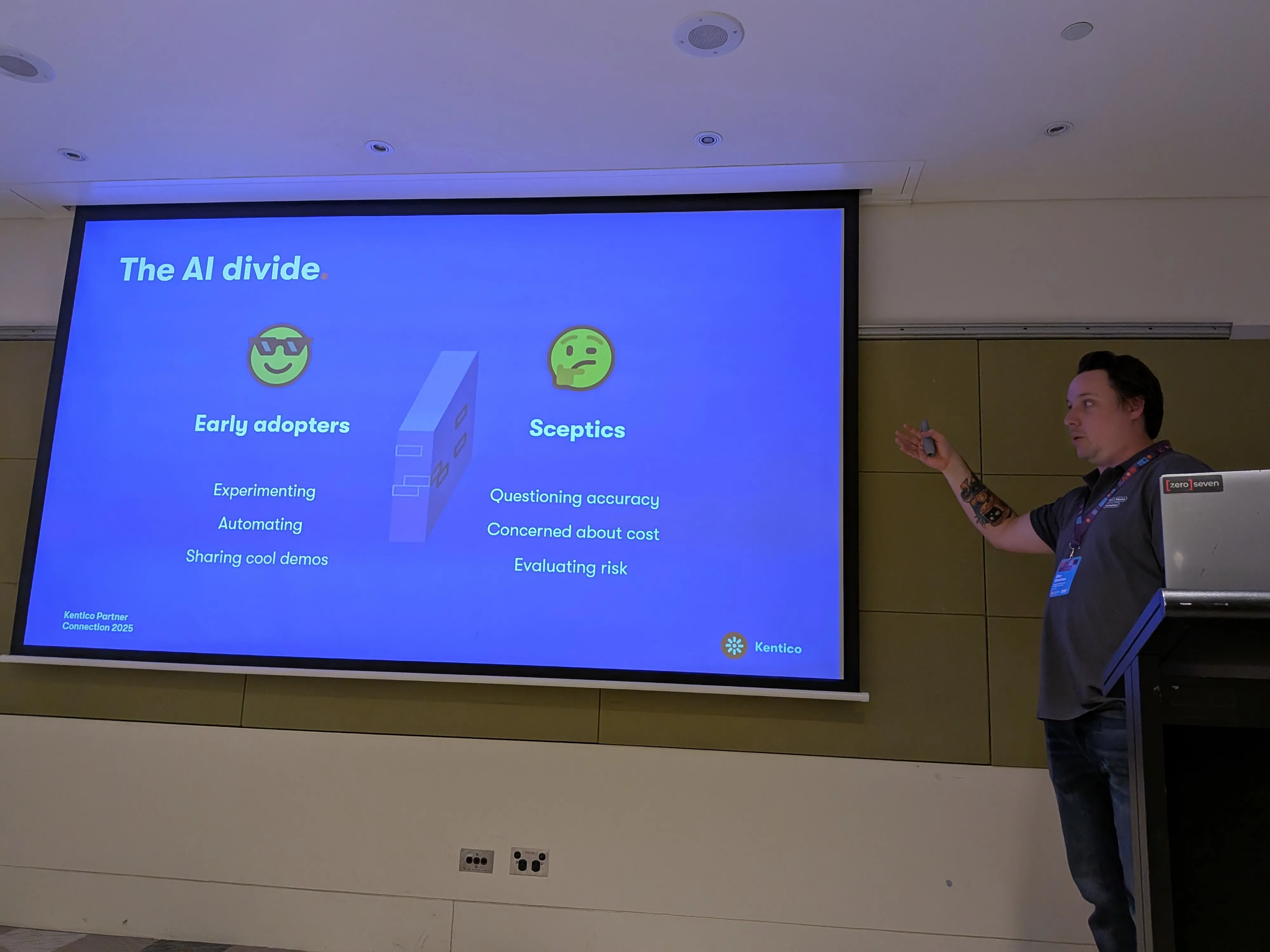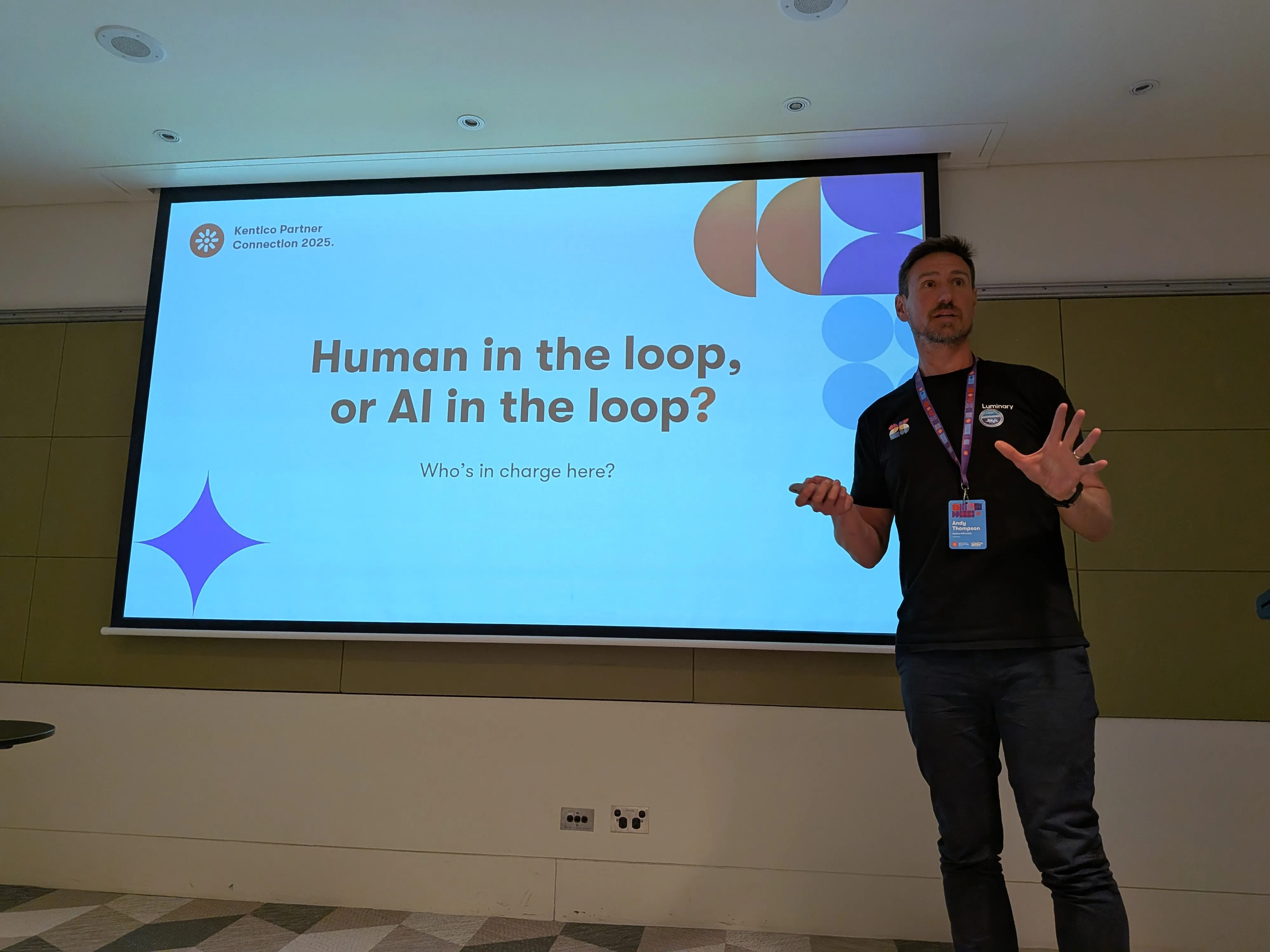The conversations about artificial intelligence at Kentico Connection APAC 2025 in Sydney were honest and constructive. One theme consistently surfaced: how do we bridge the divide between AI skeptics and AI enthusiasts - and move from debate to meaningful adoption?
This wasn’t a room filled with hype or fear. It was filled with curiosity and a willingness to explore and share experiences. Developers and digital leaders came together to share not only their excitement for AI, but also their frustrations, doubts, and hard-earned lessons.
By the end of the event, one thing was clear: AI isn’t dividing us anymore, it’s starting to connect us.
From Scepticism to Confidence: The ZeroSeven Perspective
Ben Quinlan, Director and Solution Architect at ZeroSeven, opened with a message that resonated deeply across the partner community: the AI divide is real - but it’s shrinking.
Citing the 2025 Stack Overflow survey, Ben noted that over 80% of professional developers now use AI tools, up from 63% just a year earlier. Yet, within those numbers, two groups persist - the early adopters who are experimenting and sharing demos, and the sceptics who still question accuracy, cost, and risk.
Ben shared his own evolution from sceptic to believer. Early attempts at using AI were frustrating:
“It took longer to do things with AI than to do them myself. The results were inconsistent. Context was missing. I didn’t trust it.”
What changed for him? Seeing real-world solutions that delivered quantifiable results. He explained that for his team, AI became practical when it started helping with tasks like:
· Migrating code and content types between platforms.
· Scaffolding new components and pages following existing conventions.
· Automating code reviews for instant feedback.
· Generating and maintaining documentation directly within Kentico projects.
Ben’s advice for fellow technical leaders was simple but powerful:
“Train your teams, replace the repetitive, work toward end-to-end solutions — but never compromise on quality.”
From this perspective, AI is not a shortcut or a job replacer; it’s an amplifier that removes ‘low-value busy work’ and helps developers to focus on creative quality solutions.
Human in the Loop - or AI in the Loop? The Luminary Debate
From there, Andy Thompson, CTO of Luminary and a long-time Kentico MVP, explored the philosophical and practical side of the discussion: who’s really in charge here - humans or AI? His talk, “Human in the Loop or AI in the Loop?”, challenged attendees to think critically about where responsibility lies.
Andy drew a humorous but insightful comparison:
· Human in the AI loop: trusting AI to handle most of the work, with humans occasionally stepping in - the “Skynet model.”
· AI in the human loop: humans doing the work, with AI assisting - the “Star Wars model,” where droids are helpful but humans still “use the Force.”
He made a compelling case for the second model: “AI can automate steps, but only humans can make the strategic and ethical calls. The goal isn’t to replace human oversight - it’s to enhance it.”
He showcased examples of “AI in the loop” done right:
· AI code reviews that provide fast feedback while humans retain final judgment.
· DevOps bots that classify issues and route them to the right expert.
· Automations and workflows where AI handles repetitive tasks within clear, human-designed boundaries.
· Translation and content enhancement, where human creativity sets the tone and AI scales it.
Andy’s closing message summed it up well: “Our jobs are safe - as long as we stay experts at implementing AI, not just the humans stuck in its loop.”
The Demo that surprised (& challenged) many
One of the most talked about session, however, was the Product Update and Sean Wright’s product demonstration in particular, where he showcased how to use Kentico MCP documentation server to execute three common developer scenarios without ever having to write a line of code.
Sean showcased how AI agents, guided through Kentico’s Model Context Protocol (MCP) documentation server, could break down complex implementation tasks into manageable pieces, automatically generate the right prompts, and execute them intelligently.
In real time, he demonstrated how they could generate widgets following Kentico’s best practices, and most impressively, how an agent could upgrade an entire, one year old Xperience by Kentico project to the latest release, resolving any breaking changes along the way. As many partners find it challenging to keep all of their Kentico projects up to date with the latest monthly refresh (yes I know we’ve set a challenging pace of feature releases!), Sean showed them how quickly these updates can now be applied.
This wasn’t theoretical AI - it was practical, contextual, and deeply relevant.
You could feel the room shift. I swear I saw some eyes boggling a little! Even long-time sceptics were leaning forward, phones were out and the demo steps were being captured for inspiration upon return to the office.
Setting the Tone for the Road Ahead
Sean’s demo perfectly set the stage for my session on our growing AI developer toolkit designed to help partners reduce the time involved in implementing Xperience by Kentico projects.
Our product strategy builds directly on what we saw in that room:
· Reduced coding with AI-assisted scaffolding, component generation, and upgrade support.
· AI-accelerated content operations, driven by AIRA’s translation and variant capabilities.
· Agentic architecture, where agents like those Sean demonstrated can perform structured, permission-aware actions within your projects.
It’s all part of our commitment to “faster time to market” - helping partners deliver more efficiently while maintaining creativity, control, and quality.
Because when we talk about the agentic experience, this is what we mean: humans remain the decision-makers, while AI is there to handle the heavy lifting behind the scenes.
Bridging the Divide
Throughout the sessions in Sydney, I was impressed to see that even the AI sceptics weren’t stonily silent. Instead, they were asking deeper questions, testing ideas, and - most importantly - getting inspired.
That’s how the AI divide closes: not through persuasion, but through participation.
When developers see AI helping them upgrade projects, resolve breaking changes, or scaffold components they can trust, resistance turns into curiosity - and curiosity becomes confidence.
Looking Forward: Collaboration Over Conviction
The AI conversation will keep evolving, but the lesson from APAC was clear: the most successful agencies aren’t choosing sides - they’re choosing collaboration.
At Kentico, our role is to keep building that bridge between innovation and reliability, automation and artistry, human creativity and machine precision.
As we move forward, we’ll continue adding tooling for agentic software development, expanding AIRA’s capabilities, and helping our partners to adopt and benefit from agentic development practices so they can deliver faster, better, and smarter.
Because the future of AI in digital experience isn’t about who’s right - it’s about what we can build together.
The sceptics keep us honest. The enthusiasts push us forward. But somewhere in between the two is where innovation truly lives.

Debbie Tucek
VP Product at Kentico. Product team leader, and former Marketing Executive, with more than 10 years’ experience across the product management and marketing spectrum – from startups to large organizations - I’m passionate about designing cloud software products and end-to-end services that customers love to use. My superpowers include my unending passion & enthusiasm for what I do and the problems my products solve, and my ability to project this passion to motivate others, be that in grooming sessions or on the international stage.



-(1).webp?language=en-US)